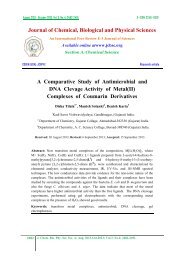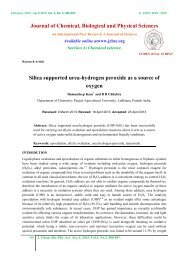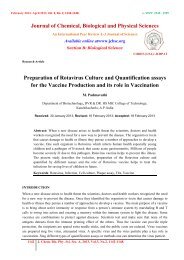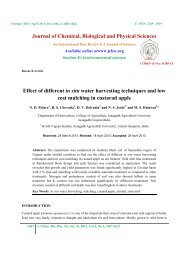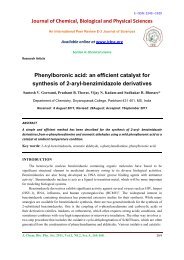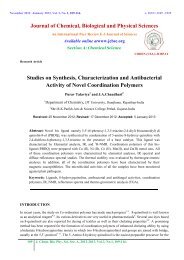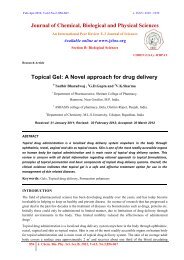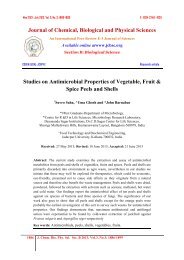Investigation of Inter polymer Complexation between Carbopol 974 ...
Investigation of Inter polymer Complexation between Carbopol 974 ...
Investigation of Inter polymer Complexation between Carbopol 974 ...
- No tags were found...
Create successful ePaper yourself
Turn your PDF publications into a flip-book with our unique Google optimized e-Paper software.
February 2013- April 2013, Vol. 3, No. 2, 1123-1131. E- ISSN: 2249 –1929Journal <strong>of</strong> Chemical, Biological and Physical SciencesAn <strong>Inter</strong>national Peer Review E-3 Journal <strong>of</strong> SciencesAvailable online atwww.jcbsc.orgSection B: Biological ScienceCODEN (USA): JCBPATResearch Article<strong>Investigation</strong> <strong>of</strong> <strong>Inter</strong> <strong>polymer</strong> <strong>Complexation</strong> <strong>between</strong><strong>Carbopol</strong> <strong>974</strong> P and Different Grades <strong>of</strong> Polyvinylpyrrolidone and Effects on Swelling Properties,Adhesion Strength and Release RateJyostna S.Patil*, Chandan R.Rane, Yashvant ChikteL.M.C.College <strong>of</strong> Pharmacy Faizpur, IndiaReceived: 25 December 2012; Revised: 6 February 2013; Accepted: 14 February 2013Abstract: The main purpose <strong>of</strong> this work was to investigate inter<strong>polymer</strong>complexation <strong>between</strong> carbopol <strong>974</strong>P and different grades <strong>of</strong> polyvinylpyrrolidone(K25,K30,K90,VA/S-630)by studying their water retaining capacity, apparent density,conductivity, pH, FTIR, swelling properties, adhesion strength and releaserate.<strong>Inter</strong><strong>polymer</strong> complexation obtained <strong>between</strong> CP and all PVP grades but mostexpressively with PVP K90, maximum amount <strong>of</strong> fresh and dried CP-PVP K90complex obtained at a weight ratio <strong>of</strong> 1:1.the water retaining capacity <strong>of</strong> all CP-PVPK90 complexes were above 90%. Increased in CP concentration caused decreased inpH with increase in conductivity for all CP-PVP complexes and apparent density <strong>of</strong>the CP-PVP K90 filtrate was lowest.IR spectrum <strong>of</strong> the CP-PVP K90 complex issimilar to that <strong>of</strong> PVP K90. Means CP has interacted with PVP K90.disc <strong>of</strong> physicalmixture <strong>of</strong> CP-PVP K90 swelled progressively and reached after 18-25 hr. Adhesionstrength was correlated with concentration <strong>of</strong> CP. Nevertheless, adhesion strength <strong>of</strong>CP-PVP K90 complex was lower than the physical mixture <strong>of</strong> the pure <strong>polymer</strong>s.<strong>Inter</strong><strong>polymer</strong> complexation was most conspicuous <strong>between</strong> CP and PVP K90.Keywords:<strong>Carbopol</strong> <strong>974</strong>, Polyvinyipyrrolidone (K25, K30, K90, VA/S630),<strong>Inter</strong>polymar complex.1123 J. Chem. Bio. Phy. Sci. Sec.B , 2012-2013, Vol.3, No.2, 1123-1131.
<strong>Investigation</strong>...Jyostna S.Patil et al.INTRODUCTIONPolymers are commonly and widely used as excipients in the design and development <strong>of</strong> a controlled andor sustained-release product. Depending on the their physicochemical properties, Often, it is notuncommon to use two or more <strong>polymer</strong>s in a formulation to develop pharmaceutically acceptable product.varied structure and chemistry <strong>of</strong> various <strong>polymer</strong>s that are available for use in pharmaceuticalpreparations, however, may render ample opportunity for them to undergo physical and: or chemicalinteraction in-situ. Such interactions may greatly influence product stability, modify drug release kinetics,Satoh 1 reported that the use <strong>of</strong> a 3:2 weight ratio <strong>of</strong> hydroxylpropylcellulose (HPC) and carboxyl vinyl<strong>polymer</strong> (CP) as excipients in tablets significantly decreased the bioadhesion force and greatly affected thedrug release 1 .) Recently 1 , the interaction <strong>of</strong> CP with HPMC and sodium carboxymethylcellulose (NaCMC)and its effects on the bioadhesive strength and the release <strong>of</strong> verapamil have been reported 2,3 . Elegakeyand Elgindy 3 prepared PVP-polyacrylic acid (<strong>Carbopol</strong> 934, 940, and 941) complexes and demonstratedtheir use in the development <strong>of</strong> sustained-release drug products 3 . Studies suggested that hydrogen bonding<strong>between</strong> carbonyl groups <strong>of</strong> PVP and the carboxyl groups <strong>of</strong> polyacrylicacid may be the driving force forthe complexation <strong>between</strong> PVP and polyacrylic acid 4-6 . Takayama and Nagai 7 reported that PVP forms a1:1 complex with carboxyvinyl <strong>polymer</strong>. Gupta et al 2 . reinvestigated the interaction <strong>between</strong> <strong>Carbopol</strong> 934and PVP. The degree <strong>of</strong> complexation Was found to be higher at low acidic conditions, and decreased withincreasing pH <strong>of</strong> the solution 2 .<strong>Carbopol</strong> are synthetic high-molecular-weight <strong>polymer</strong>s <strong>of</strong> acrylic acid that are cross linked with eitherallyl sucrose or allyl ethers <strong>of</strong> pentaerythritol 8 .<strong>Carbopol</strong> <strong>974</strong>P is used in sustained release tabletpreparations 9 .It has mucoadheisve property, there are some reports on the application <strong>of</strong> carbopol to theextended release dosage form 9,10 . USP describes povidone as a synthetic <strong>polymer</strong> consisting essentially <strong>of</strong>linear 1-vinyl-2-pyrrolidone groups. Various grades <strong>of</strong> povidone are used in pharmaceutical formulations,primarily in solid dosage forms (wet granulation process) as a binder 11, 13 .MATERIALS AND METHODS<strong>Carbopol</strong> <strong>974</strong>P was procured from Lubrizol (India), and all grades <strong>of</strong> PVP (K 25,K 30,K 90,VA/S-630)(linear <strong>polymer</strong>s <strong>of</strong> 1-vinylpyrrolidine-2-one) were purchased from Ranbaxy (India).The viscosity forPVP K 25,L30,K90,VA/S-630 was 1.7,2.5,55,2.5 mPA.s,respectively.and the molecular weight <strong>of</strong> PVP K25,L30,K90,VA/S-630 was 9500,56000,1300000,58000 respectively.The chemical structure <strong>of</strong> carbopoland PVP are shown in Figure 1Method for preparation <strong>of</strong> <strong>polymer</strong> complex: 2% aqueous dispersion <strong>of</strong> CP and PVP K 25 were firstprepared. Appropriate amount <strong>of</strong> CP and PVP dispersions mixed to obtain and PVP weight ratio <strong>of</strong> 1:1,3:7, and 7:4(weight fraction <strong>of</strong> 30%, 50%, and 64% <strong>of</strong> CP).Total <strong>polymer</strong> concentration fixed at 2% byweight in each sample. The two <strong>polymer</strong>ic solutions stirred uniformly for 1 hour and filtered. The residueconsisting <strong>of</strong> CP-PVP complex was collected and weighs to represent the weight <strong>of</strong> fresh <strong>polymer</strong> complex(W f ) the complex subsequently dried at 110 0 C until a constant weight obtained. The dried CP _PVPcomplex was ground and sieve through no.60 mesh (250 mm) sieve, while the filtrate was collected and1124 J. Chem. Bio. Phy. Sci. Sec. B, 2013, Vol.3, No.2, 1123-1131.
<strong>Investigation</strong>...Jyostna S.Patil et al.kept for further analysis. The water retaining capacity <strong>of</strong> the complex defined as (W f -W d ) stated as apercentage.PH Measurement: CP and PVP (K25, K30, K90, and VA/S-630) mixtures at different weight ratios wasmeasured using pH meter (Sartorius, JAPAN)Conductivity Measurement: By keeping constant concentration <strong>of</strong> <strong>polymer</strong> (2%), conductivity measuredwith a cell constant 1 cm -1 at 25 0 C.(ELCO, Mumbai, India)Measurement <strong>of</strong> Apparent Density: The apparent densities <strong>of</strong> the CP and PVP (K25, K30, K90, VA/S-630) and the filtrates <strong>of</strong> CP –PVP (K25, K30, K90, VA/S-630) complexes (1:1) were determined using apycnometer at 25 0 C.FTIR Measurement: FTIR spectra <strong>of</strong> CP, PVP K90, CP-PVP K90 (1:1) solid complex were measuredusing KBr pellet method (FT-IR 401, Jasco, Tokyo, Japan) at 25 0 C.Adhesion Strength Measurement: Bioadhesive strength <strong>of</strong> disc was measured on modified physicalbalance using method described by gupta et al 2 Shown in Figure 2. The goat buccal mucosa used as amodel mucosal membrane and a Krebs solution as a moistening fluid. The experiment repeated for threetimes for each complex. Two-arm balance method reported by Parodi 12 with minor modifications and hehad was also used to check and to validate the results <strong>of</strong> the modified tensiometry method and thecorrelation <strong>between</strong> the results obtained from these two techniques was established by Parodi.Fig.2: Modified Physical balance for measurement <strong>of</strong> Mucoadhesive strengthSTUDY OF SWELLING PROPRETIESPreparing disc <strong>of</strong> 13 mm diameter containing 250 mg <strong>of</strong> CP-PVP K90 (1:1) solid complex using an IRHydraulic press, compression force was 10 kN/cm2 with a dwell time <strong>of</strong> 1 s.The complex disc wassubmerged in glass Petri dish Containing 60 ml <strong>of</strong> phosphate buffer solution. At different intervalsmeasured the increased diameter <strong>of</strong> disc with a vernier caliper at 25 o C (50 hr)Differential scanning calorimetry (DSC): Thermal analysis carried out using a differential scanningcalorimeter (DSC 50, Shimadzu Scientific Instruments, MD, and USA). The samples placed in analuminum-sealed pan and preheated to 200 ◦C. The sample was cooled to room temperature and thenreheated from 40 to 450 ◦C at a scanning rate <strong>of</strong> 10 0 C/minIn vitro drug release study: Drug release study for Acyclovir, which used as model drug. The extendedreleasematrix tablets with a total weight <strong>of</strong> 250 mg were prepared using a mixture <strong>of</strong> Acyclovir and CP-PVP K90 complex at 1:1. The mixture compressed using a hydraulic press with a 13-mm diameter. Thecompression force was 10 kN/cm 2 with a dwell time <strong>of</strong> one second.1125 J. Chem. Bio. Phy. Sci. Sec. B, 2013, Vol.3, No.2, 1123-1131.
<strong>Investigation</strong>...Jyostna S.Patil et al.WATER RETAINING CAPACITY AS AFUNCTION OF CP-PVPCOMPLEXES50%CP 30%CP 80%CPWATER RETAINED(%)100806040200CP K25 CP K30 CP K90 CPVA/S630POLUMER COMPLEXFig.2: Water retaining capacity as a function <strong>of</strong> cp-pvp complexesEffect <strong>of</strong> apparent density: Following figure indicates apparent density values <strong>of</strong> pure <strong>polymer</strong> grades(K25, K30, K90, and VA/S-630) solutions and all CP-PVP (complex) filtrates. There was no significantdifference (p>0.005) in the apparent density values among the various density values. The apparent density<strong>of</strong> filtrates <strong>of</strong> CP-PVP K90 complex was lowest among all the filtrates. The apparent density <strong>of</strong> filtrates<strong>of</strong> CP-PVP (K25, K 30, VA /S630) complex was highest than their respective PVP solution.Apparent density as afunction <strong>of</strong> CP-PVP complexespure carbopol pure pvp filtrates <strong>of</strong> complexes1.2apparent density (%)10.80.60.40.20CP K25 CP K30 CP K90 CP VA/S630<strong>polymer</strong> complexFig.3: Apparent density as a function <strong>of</strong> CP-PVP complexes1127 J. Chem. Bio. Phy. Sci. Sec. B, 2013, Vol.3, No.2, 1123-1131.
<strong>Investigation</strong>...Jyostna S.Patil et al.Effect on pH: 2% dispersion <strong>of</strong> CP,PVP k25,K30,K90,and PVP VA/S 630 has a Ph values <strong>of</strong>2.9,4.7,3.72,3.7 respectively at 25 0 C. Aqueous dispersion <strong>of</strong> carbopol exhibited pH values <strong>between</strong> 2.8to3.2, depending on its concentration. Generally, increase the concentration <strong>of</strong> CP decreased in pH for all thecomplexes. All the CP-PVP complexes were insoluble in acidic aqueous solution but decomplexationtooke place in basic media (Ph 7), which was adjusted with 2 M NaOH.Effect on Conductivity: Conductivity can be used to indicate and estimate the degree <strong>of</strong> complexation<strong>between</strong> <strong>polymer</strong>s in aqueous solution. All grades <strong>of</strong> PVP9 K25, K30, K90, VA /S630 interacted with CP.and conductivity was positively correlated with concentration <strong>of</strong> CP.Increase in conductivity was observed forCP-PVP K90 complex when the CP concentration wasincreasedfrom 50 to 90%, while below 50% <strong>of</strong> CP, there wasonly a gradual increase similar to the rest <strong>of</strong> theCP-PVP complexes. This indicates that at a lowerCP concentration, the insoluble complex was surroundedby poor conducting PVP solution. And At a higherCP concentration, a larger amount <strong>of</strong> flocculatedinsoluble complexes were obtained, which leads to increasedthe conductivity .means generation <strong>of</strong> ionsresponsible for conductivity.FTIR spectral analysis: The complexation was most prominent <strong>between</strong>CP and PVP K90, furtherstudies including FTIR spectral analysis, adhesion strength and swelling studies, Release rate were carriedout. The FTIR spectra <strong>of</strong> CP, PVP-K90 and dried CP-PVPK90 (1:1) complex are given in Figure 4.Fig.4: FT-IR spectra <strong>of</strong> CP-PVP K 90 Complex, PVP K90, and CP <strong>974</strong>P.Effect on adhesion strength: The detachment force (D f ) and work <strong>of</strong> adhesion (W adh ) <strong>of</strong> disc preparedfrom physical mixture and solid complexes <strong>of</strong> the CP-PVP K90 at ratio 1:1 to the goat buccal mucosalmembrane is shown I following table.It was found that D f and W adh were linearly related to CP content. Anincrease in CP content caused an increase in D f and W adh . On the other hand the significant decrease in Df1128 J. Chem. Bio. Phy. Sci. Sec. B, 2013, Vol.3, No.2, 1123-1131.
<strong>Investigation</strong>...Jyostna S.Patil et al.and W adh were obtained <strong>between</strong> disc prepared from physical mixtures and solid complexes <strong>of</strong> CP-PVP K90, at a fixed CP %(p
<strong>Investigation</strong>...Jyostna S.Patil et al.IN VITRO DRUG RELEASEFigs. 6 and 7 show the dissolution pr<strong>of</strong>iles <strong>of</strong> Acyclovir from the matrix tablets containing CP-PVP K90complex in pH 6.8 phosphate buffer and pH 1.2 HCl solutions, respectively. The rate <strong>of</strong> drug dissolutionfrom the CP-PVP K90 complex tablet was extended than that from the individual extended release<strong>polymer</strong> matrix tablet. Polymer tested at pH 1.2. In addition, the rate <strong>of</strong> drug dissolution from the complextablet in pH 6.8 was extending than that at pH 1.2. This might be due to the Bioadhessive property <strong>of</strong>carbopol <strong>974</strong>p at a high pH, which extend the rate <strong>of</strong> drug release from the tablet. The <strong>Carbopol</strong> matrixtablet, the rate <strong>of</strong> drug dissolution was influenced by the pH <strong>of</strong> the dissolution medium. Almost all thecarboxyl groups will dissociate at pH 6.8 resulting in the formation <strong>of</strong> a swollen gel. However, thecarboxyl groups <strong>of</strong> <strong>Carbopol</strong> Will not dissociate at pH 1.2 resulting in a less viscous hydrogel (Bonacucinaet al., 2004). Therefore, the rate <strong>of</strong> drug dissolution from the <strong>Carbopol</strong> matrix at pH 6.8 was slower thanthat <strong>of</strong> the drug at pH 1.2. The <strong>Carbopol</strong>/Polyvinylpyrrolidone IPC matrix tablets showed much less pHdependency than the <strong>Carbopol</strong> tablets. The dissolution pr<strong>of</strong>ile <strong>of</strong> Acyclovir from the CP-PVP K90 IPCmatrix tablet was compared with that from the PVP and carbopol.Release study <strong>of</strong> acyclovir in pH 1.2% drug release8060402000 50 100 150time (mins)<strong>Carbopol</strong>PVPComplexFigure 6: Release study <strong>of</strong> acyclovir in pH 1.2Release study <strong>of</strong> Acycolvir in ph 6.8% drug release1501005000 100 200 300time (mins)carbopolpvpcomplexFigure 7: Release study <strong>of</strong> Acycolvir in ph 6.81130 J. Chem. Bio. Phy. Sci. Sec. B, 2013, Vol.3, No.2, 1123-1131.
<strong>Investigation</strong>...Jyostna S.Patil et al.CONCLUSION<strong>Inter</strong><strong>polymer</strong> complexation occurred <strong>between</strong> carbopol <strong>974</strong> and polyvinylpyrrolidone.but to differentextent for the various grades <strong>of</strong> polyvinylpyrrolidone. <strong>Complexation</strong> was most conspicuous <strong>between</strong> CPand PVP K 90 possibly due to higher viscosity and molecular weight <strong>of</strong> PVP K90. In addition, the swellingand adhesion properties <strong>of</strong> the CP-PVP K90 solid complex found to be distinguishable from the physicalmixture <strong>of</strong> pure <strong>polymer</strong>s.ACKNOWLEDGEMENTThe authors are thankfull to Lubrizol (India) for supplying carbopol <strong>974</strong>, and also thankfull to PrincipalLMC College <strong>of</strong> pharmacy Faizpur. For providing the facilities necessary to carryout the experiments.REFERENCES1. K. Satoh, K. Takayama, Y. Machida, Y. Suzuki, M. Nakagaki,T. Nagai, Factors affecting the bioadhesiveproperty <strong>of</strong> tablets consisting <strong>of</strong> hydroxypropyl cellulose and carboxyvinyl <strong>polymer</strong>, Chem. Pharm.Bull.1989, 37, 1366–1368.2. A.Gupta,S. Garg, R.K. Khar, <strong>Inter</strong><strong>polymer</strong> complexation and its effect on bioadhesive strength anddissolution Characteristics <strong>of</strong> buccal drug delivery. Drug Dev. Ind. Pharm. 1994, 20, 315–325.3. N.A. Elegakey, N.A. Elgindy, Drug encapsulation by <strong>Carbopol</strong>-polyvinylpyrrolidone flocculation technique.Sci. Pharm. 1981,49, 434–441.4. T. sutsui, H. Nakano,R. Tanaka,T. Tanaka, Physical Properties <strong>of</strong> inter<strong>polymer</strong> complexes from polyacrylic Acid and poly vinylpyrrolidone. Kobushi Ronbunshu, 1978, 35,517–524.5. E.Tsuchida,Y. Osada, H. Ohno, H., Formation <strong>of</strong> inter<strong>polymer</strong> Complexes. J. Macromol. Sci. Phys.1980,B17, 683–714.6. N.Saski,T. Yokoyama, The behaviors <strong>of</strong> intermolecular hydrogen bonds in the poly (acrylic acidpol(vinylpyrrolidone).1984.7. K. Takayama, T. Nagai, Application <strong>of</strong> inter<strong>polymer</strong> <strong>Complexation</strong> <strong>of</strong> polyvinylpyrrolidone: carboxyvinyl<strong>polymer</strong> to control <strong>of</strong> drug release. Chem. Pharm. Bull.1987, 35, 4921–4927.8. Raymond C Rowe, Paul J Sheskey, Sian C Owen.’ Handbook <strong>of</strong> pharmaceutical Exepients’ fifthedition,2006, 111-113.9. M.M.Meshali,G.M. El-sayed,Y. El-saied, et al.preparation and evaluation <strong>of</strong> theophylline sustained releasetablets, Drug Dev pharm Ind 1996 ;22 (4):373-376.10. G.V. Betageri,D.V. Deshmukh,R.B. Gupta, Oral sustained release Bioadhesive tablet formulation <strong>of</strong>Didanosine. Drug Dev. Ind. Pharm.2001, 27,129-136.11. B. Parodi,E. Russo,G. Caviglioli,S. Cafaggi,G. Bigbardi, Development and characterization <strong>of</strong> abuccoadhesive dosage form <strong>of</strong> oxycodane hydrochloride. Drug Dev Ind Pharm,1996, 22 (5):445 450.12. G. Bonacucina, S. Martelli,G.F. Palmieri, Rheological, mucoadhesive and release properties <strong>of</strong> <strong>Carbopol</strong>gels in hydrophilic cosolvents. Int. J.Pharm. 2004,282, 115–130.13. S.D. Jones,A.D. Woolfson and A.F. Brown, Tex tural, viscoelastic and mucoadhesive properties <strong>of</strong>pharmaceutical gels composed <strong>of</strong> cellulose <strong>polymer</strong>, Int. J. Pharm151223-233, 1997*Corresponding author: Jyostna S.Patil; M.Pharm Scholar, L.M.C.College <strong>of</strong>Pharmacy Faizpur1131 J. Chem. Bio. Phy. Sci. Sec. B, 2013, Vol.3, No.2, 1123-1131.



